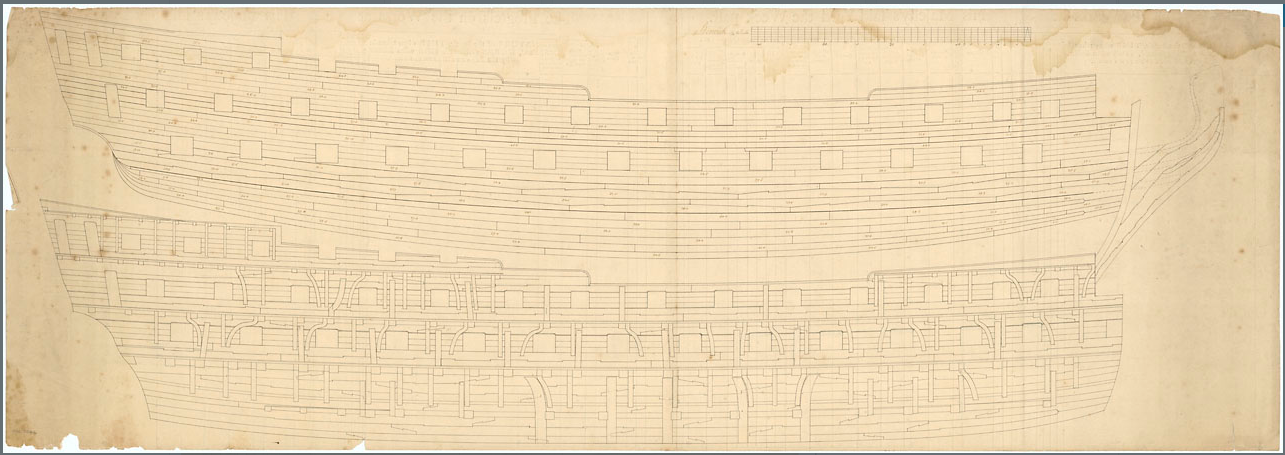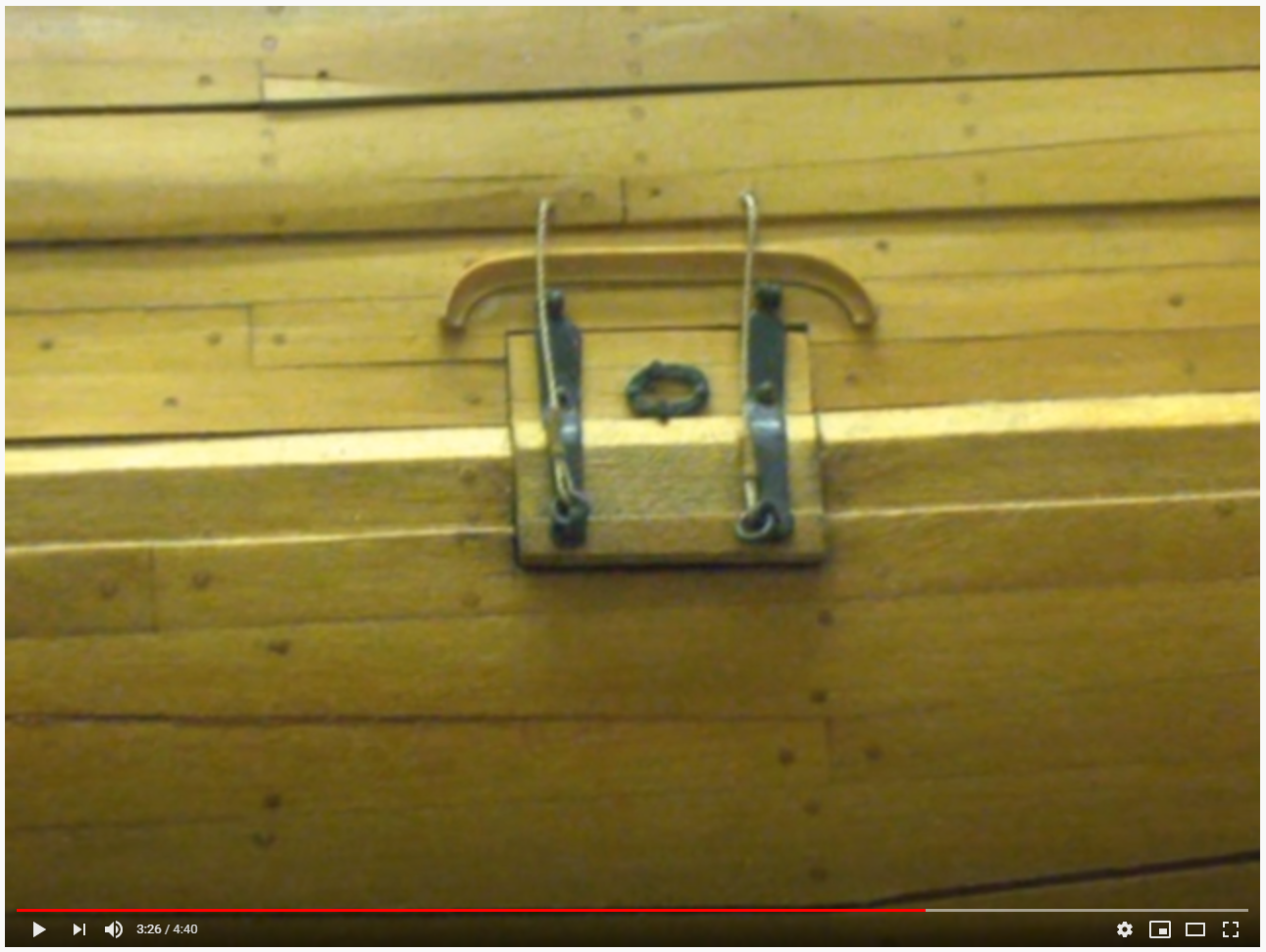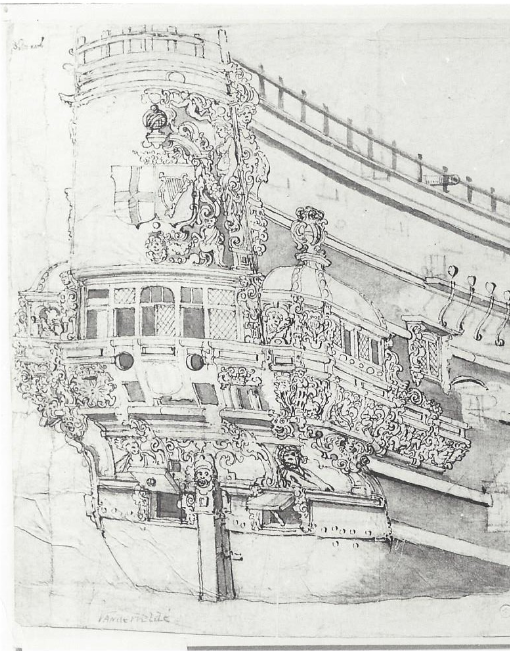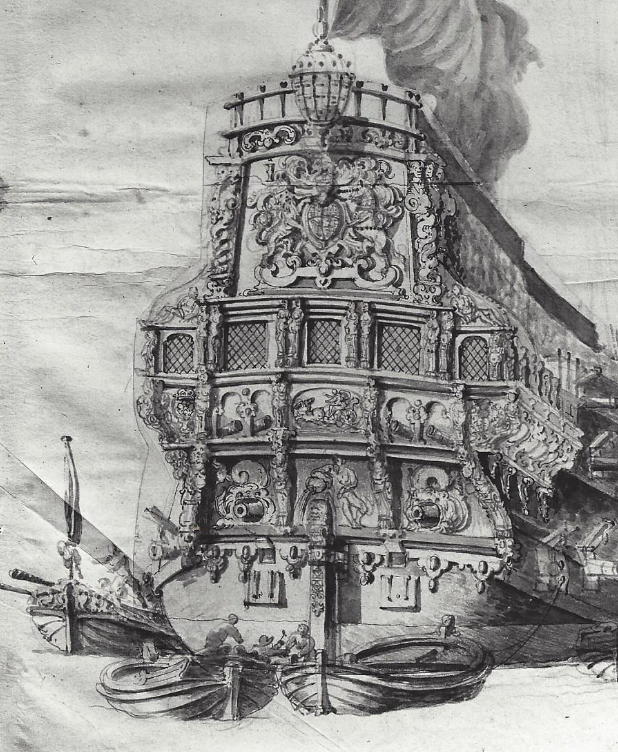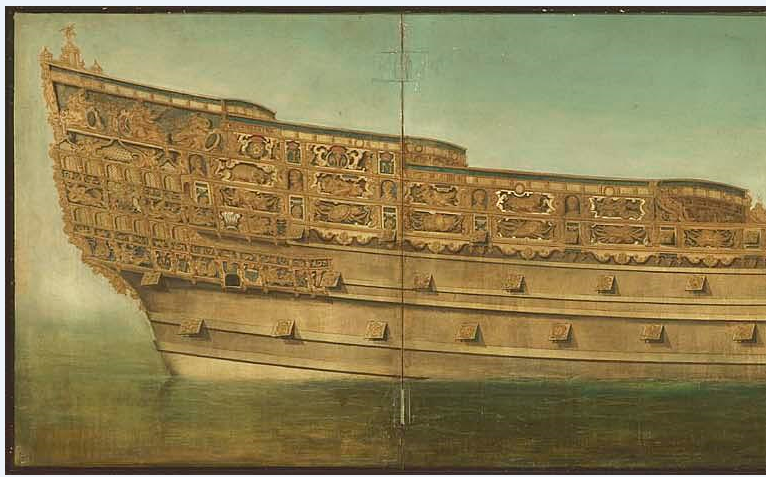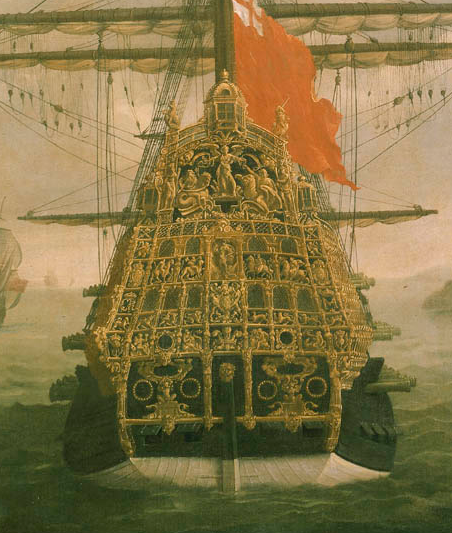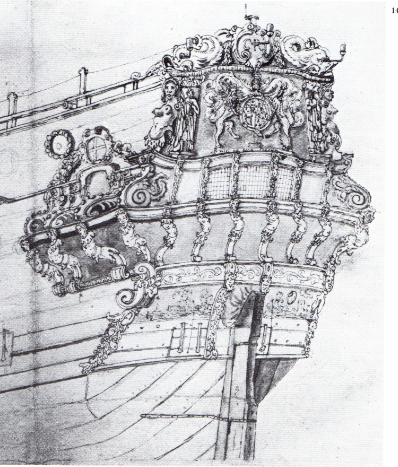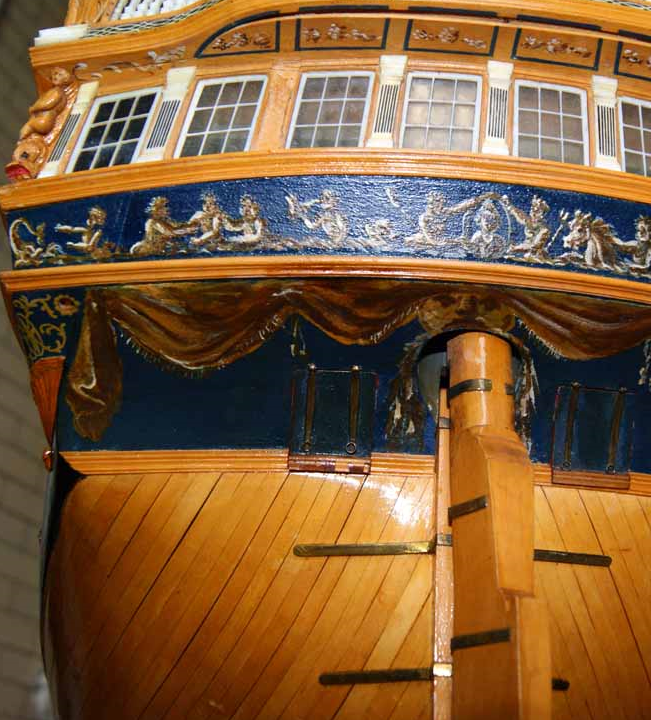-
Posts
1,770 -
Joined
-
Last visited
Content Type
Profiles
Forums
Gallery
Events
Everything posted by Mark P
-
Good Morning Mark; I am slightly surprised by your desire to paint the spirketting black. Just to be sure, this is inboard works, and the Bellona model in the NMM has its gundeck spirketting painted red (and the quickwork) All other models I have seen have their spirketting red, or natural wood colour. Do you have a reason for choosing black. I am fairly sure that I have seen references to gundeck sides being painted in a stone colour (a pale buff) and perhaps yellow ochre also; but I have never seen any mention of black being used. All the best, Mark P
-
Thanks Druxey for posting this; It is an ongoing tragedy: the dive team are banned from removing any objects from the sea-bed, however exposed they are; while the English Heritage 'experts' sit on their hands over what can be done with the site. They make an arthritic snail seem like an Olympic sprinter in the speed of their progress. I heard Mark Beattie-Edwards give a fascinating talk on this earlier this year, in Southend, along with Richard Endsor and other interested parties. I would be certain that EH have not advanced one syllable from what they had achieved then; which was nothing good. I just hope that the divers will manage to retrieve material which the prop wash has moved further away, out of the 'protected' (read 'rapidly deteriorating') wreck-site. All the best, Mark P
-

Keel taper question
Mark P replied to bruce d's topic in Building, Framing, Planking and plating a ships hull and deck
To respond to Jaager's comment re the additional cost of labour to provide a taper, I don't think that this would be a consideration. The essential point is that a tapering keel can be obtained from less costly, smaller sections of rough timber. The actual creation of the taper would be done when the timber was sawn. Many of a ship's timbers were sawn to both the sided and moulded dimensions, as it was much quicker than dubbing. A gentle taper would be no problem for skilled sawyers. All the best, Mark P -
Thanks Louie; An excellent review; I am always on the look-out for new books for the ever-expanding library (one can never have enough; although my dear Admiral might disagree, bless her) It sounds as though the professor is more comfortable 'sailing' in Northern waters, and knew less of the Med, perhaps. Nonetheless, I will keep an eye out for this, as my main interest is English vessels. All the best, Mark P
-

Keel taper question
Mark P replied to bruce d's topic in Building, Framing, Planking and plating a ships hull and deck
Good Afternoon Bruce; This is a much-debated point. I did once see an explanation of where the taper began, but I cannot for the life of me remember where it was. However, to answer your question, but only in respect of the Royal Navy methods (however, merchant builders would almost certainly have followed a technique which allowed them to use thinner timbers at any part of a build, thereby saving money) the central section was parallel-sided. This extended some distance fore and aft, and seems to have taken up approximately half the keel length. However, that does not mean that a quarter of the length each end was tapered. As the keel at the bow was much less tapered than the stern, the length of the stern taper is much longer than the bow. if you split the remaining half of the keel into thirds, and allow two thirds at the stern, and one third at the bows, you will be about right. Another point is that the taper is not constant (judging from the body lines on draughts) but becomes sharper towards the extremities; so that the narrowing is actually slightly curved. I would be happy, though, to hear from other members who know anything more precise. All the best, Mark -
Good Morning Gentlemen; One thing to keep in mind is that nautical terms often shifted meaning over the years. Sir Henry Manwayring's Seaman's Dictionary, written ca 1630, lists and defines quite a few words which later came to mean something different to his description. The curve in the decks, as seen from the side, was also sometimes referred to as the 'Hanging of the deck'. With reference to Hamilton's question, as Druxey says above, the curvature of the hatches (referred to as the 'round up') varied. In the absence of any verifiable information, though, the best approach is probably to give them a curvature somewhat greater than the deck, as this seems to have been the most usual. All the best, Mark P
-
Good Afternoon Vladimir; I see that you are still as productive as ever; that's fast work on the deckhouses. Nicely done with the panelling and doors, it is all looking good. Nice photograph of her outside, she looks very impressive. Keep up the good work; it is all very interesting to look at. All the best, Mark P
- 200 replies
-
- cutty sark
- clipper
-
(and 1 more)
Tagged with:
-
Good Morning Gary; Thank you for the pictures of the earlier stages of building. Excellent quality work as always. Mark, the jointing of the two strakes of spirketting is a 'tabled' joint, and is referred to in some contracts, either for spirketting, or for deck clamps. If you do have the Berwick draught which Gary mentions, look at the method of jointing the string in the waist to the forecastle deck clamp; it's very interesting. All the best, Mark P
-
Good Evening Allan; I have seen similar references in contracts, to the wedge system you show in your picture. The sentence you quote does not necessarily ask for the saddles to be fixed immovably, in my opinion. Essentially, it only stipulates that they must be strong and able to withstand stresses. The 'To Fix Saddles..' beginning need only mean that they are located across the keel, below each mast, and able to move as is customary. The 'Fastenings' could equally well refer to the wedges and bolts, which fix the mast in the desired position for the rake. Navy officers are on record as experimenting with various angles for the masts, to discover what angle gave the best results; so adjustability was important, and is likely to have remained so until the end of sail. All the best, Mark P
-

Boarding nets
Mark P replied to bruce d's topic in Discussion for a Ship's Deck Furniture, Guns, boats and other Fittings
Thanks Bruce; I had never heard of that before. They were normally hoisted up and outwards to a block on the yards, I believe; and left hanging in slack folds, which made them harder to cut. Shipman, I think you are referring more to nets spread across what was called the spar deck, which in the first half of the 17th century, and for some time before, was a light framework of timbers which formed a roof over the upper deck. It was unarmed (no cannon) and was used for soldiers and, as mentioned, to prevent falling debris hitting the crew. It was supported by rafters which spanned from side to side, and I believe that this is the origin of the later term rough-tree rail, deriving from rafter-rail especially as rafter was sometimes spelt raftre All the best, Mark P -

Boarding nets
Mark P replied to bruce d's topic in Discussion for a Ship's Deck Furniture, Guns, boats and other Fittings
Good Morning Bruce; I am not expert in this particular field, but I believe that boarding nettings were obsolete by Nelson's era. They may have prevented an attack on a ship by boarders from another vessel, but this worked both ways, as they also prevented the ship's own crew from boarding another themselves. All the best, Mark P -
Good Evening; Does anyone know how things are going. I ordered a couple of books and have had no confirmation email or anything. The payment has been processed, so someone is presumably still watching the orders come in. Just an order acknowledgement would be a tremendous comfort. If health problems are still an issue, then it would be considerate towards the purchasers if a notice was put on the website announcing that there is no cause for concern, orders are being processed, even if one does not hear anything. That cannot be too hard to organise, surely. Overall, it's a great shame, because they publish some wonderful books and I want to carry on buying when I can afford some more. All the best, Mark P
-
Good Evening Dali; That's some very good quality work you have done for your project. Congratulations and well done indeed! All the best, Mark P
-

Types of Scarphs
Mark P replied to allanyed's topic in Building, Framing, Planking and plating a ships hull and deck
Good Afternoon Allan; There is in the NMM collections a drawing ZAZ7846, which is described as showing the internal and external planking of the Berwick of 1775 (there is nothing on the draught to verify this; possibly there is something on the back) A bit later than your period, but still useful. This shows hook and butt (otherwise known as Flemish style) planking for the external wale, and a good proportion of the inboard planking, starting with the strakes below the orlop clamp. The other deck clamps are treated likewise, and, interestingly, the spirketting is tabled. See picture below. Note the arrangement below the forecastle and quarterdeck. Search NMM collections under planking, and narrow to the 18th century. All the best, Mark P -
Congratulations Vladimir; She's looking very good, you have made a lovely job of the deckhouse and trailboards. An impressive model; keep up the good work! All the best, Mark P
- 200 replies
-
- cutty sark
- clipper
-
(and 1 more)
Tagged with:
-
Good Morning; Yet no matter how good or otherwise the glues available to Longridge were, they would not have been any less effective than those used by the Georgian and earlier modellers, whose beautiful creations continue to entrance us over two centuries later. The surviving models are generally in much better condition than the much more recent model of the Victory. So the present condition of this model is probably due to either poor storage, poor choice of timber, or to the creation of stress in the timber by forcing it into position (or a combination of any or all of these) It is otherwise a beautiful and accomplished model, so carry on as you are, Mark, and no doubt in 250 years, your model will still be a source of wonder to all who see her. I remember a very effective wood glue called 'Cascamite', which was based, I believe, on pine resin, and had to be mixed with water. It was extremely strong. I believe is first appeared in the forties, a bit too late for Dr Longridge, unfortunately. All the best, Mark P
-
Good Evening Everyone; I have seen the same as Greg, pictures with some significant movement in the planking of the Victory model. I can't remember where they were, but there is a video on youtube from 2008, before the Museum had an attack of political correctness. See a still below from it. This will encourage you, Mark! All the best, Mark P
-
Good Afternoon; Thanks Jaager for posting more information. It has been suggested to me that the ship shown in the pen and wash drawing, in the first post, is a captured Dutch vessel, with the strange knuckle due to English shipwrights either altering or repairing her stern in their round tuck style, but finding this awkward, as all Dutch warships had square tuck sterns, and no wing transom. Hence the rather amateurish look to the planking, and probably the seeming clinker-built style of it also. Especially as other English ships had perfectly well formed round tuck sterns well before the Sovereign was built. This makes it unlikely that the knuckle shown in the Lely painting of the Sovereign is there for a similar reason, so why the picture shows this is still a subject for guesswork. However, that does mean that the painting is the only evidence of any kind for the Sovereign to have had a square tuck; which should be considered in balance against a number of depictions of pre-Sovereign ships with round tucks, and the draught of the actual vessel shown above. Below on the left is a Van de Velde picture of the Garland, built in 1620; shown in the Commonwealth period, but she had not been re-built, and still has her original round tuck stern. Likewise the Convertine, on the right; built in 1616 with a round tuck stern, although the drawing is later. All the best, Mark P
-
Thanks Druxey and Jaager for your thoughts. I posted this because the preponderance of evidence for the period is that the Sovereign had a round tuck, in my opinion. If Frank Fox holds the same view, I would regard this as very strong advocacy for the same. I also believe that the portrait shows a round tuck. If it were square, as Jaager mentions, the planking would not continue the lines of the main hull planking, as the fashion piece would be partly visible, and the stern planking would stop short of the knuckle. Jaager, have you read the review in question, which raises a number of points that are hard to set aside, and which give a good indication of the actual level of research carried out by John McKay while preparing the book. It is undeniable that McKay is a draughtsman of outstanding ability, but I do believe that he has given insufficient consideration to the information available for this subject. There is a contemporary draught of the Sovereign available. It was found in the early 20th century, in the London house where Samuel Pepys once lived. This is also mentioned by Pepys as being amongst his possessions. For about the last hundred years it has been in the collections of the Boston Museum of Fine Arts (copies are available at an extortionate price) The provenance of this is accepted as genuine. It has been colour-washed, and shows the decoration of the side in great detail, at a scale of 1:48 This draught also shows the tuck, in side view, with gradually fading shading running away from the line of the stern. It is very difficult to disagree that this shows a rounded shape. The reflection on the surface of the water shows the same thing. Re the apparent width of the planks, although I think they are reasonable, two things might be of interest: the very different timber supply situation for the early 17th century must be borne in mind; I have seen floorboards in houses of that date, which are 2 feet wide (not that I am advocating that the planks here are that width) Secondly, the Sovereign had a notedly narrow stern, which was one reason for her unpopularity amongst admirals, and explains why she almost never served as a flagship. Given the choice, they preferred other first-rates with wider accommodation. All the best, Mark P
-
Good Afternoon; The recent publication of John McKay's book 'Sovereign of the Seas', which purports to give an accurate representation of the ship as built in 1637, has resulted in some fairly caustic reviews appearing on Amazon. This includes one from Frank Fox, probably the foremost expert in ships and Naval history of this period, who is deeply thanked by McKay for his help with the preparation of the book. Frank Fox starts his review with the comment that although McKay asked for his advice and comments, this was then largely ignored, so he wishes to counter the impression created that he has endorsed the book, when in fact he has no wish to be associated with it, as it contains too many inaccuracies. The largest of these centres around the shape of the stern: was she a round-tuck, or a square-tuck? Frank Fox is adamant that she was built with a round tuck, and cites ample examples to prove this. John Mckay's reconstruction shows her with a square tuck, with his reason for assuming this largely based on the well-known portrait of Peter Pett, the builder of the Sovereign, by Peter Lely. This can be interpreted as showing a square tuck (although the planking is quite clearly curved, and almost vertical, both as is normal for a round tuck stern; square tucks had straight, diagonal planking) However, it is undeniable that the outer portion of the stern does show a 'knuckle', or sharp angle. According to one's point of view, this can be taken as proof of a square tuck (despite the curved planking) or as an error on the part of the painter, who knew nothing of ships (Peter Lely was a portrait painter, and is very unlikely to have ever gone near Chatham where the Sovereign was generally laid up or moored) However, maybe an injustice has been done to Lely, and he has actually painted an accurate portrait of her (or whoever did paint it; there is no certainty that Lely actually painted the ship's stern at all, or even the portrait of Pett) Compare the three pictures below. These show part of the Sovereign/Pett painting (which is held by the National Maritime Museum) and adjacent is a drawing taken from the book 'Sailing Ships of War', by Dr Frank Howard (highly recommended if you do not have it) This shows a sketch of an English third rate in around 1634 (although this identification is not certain) She certainly has the English coat of arms, and a CR monogram. Most interesting, though, is the planking around the buttocks. This could be what is portrayed in the Sovereign painting. The final picture shows part of the stern of a model of Warrior, which shows the run of the planking in a round tuck very well. I have not yet seen McKay's book, although I do intend to purchase a copy, as the drawings of the decoration are, according to Frank Fox and other reviewers, very good. All the best, Mark P
-
Good Morning Kurtis; No worries about whatever level of accuracy you stop at. This is your project, and only you know exactly when you will be at the result you need. Re quarter galleries, this is no reference to their proportion of the ship, as Mark says above. The quarter is the term used to describe that particular area of the ship; in this case, the area adjoining the sharp angle where the stern meets the ship's side. It also give a direction. For example, a lookout hailing down to the deck to report sighting something, would shout: 'sail ho! Off the starboard quarter!' Thereby giving those on deck the direction in which it lay. Don't take Wikipedia as gospel. They do have a lot of good information there; but the sailing Navy is too vast a subject for accurate detailed knowledge of it to be widespread, and I have seen more than a few errors in some articles. I corrected some, but not all of them. Quarter galleries were occasionally damaged by heavy seas, but the complete loss of one was rare, and more likely to occur during a battle. All the best, Mark
-
Good Evening John; David White's series of articles are well illustrated, and very informative. However, if your period of interest is the 17th century, most of what he wrote will be of no specific help to you, as he concentrated mostly on shipbuilding in the second half of the 18th century. Earlier periods are not much covered, and techniques then were very different. His articles will certainly help you to understand a draught, though, which is useful. Rather unfortunately, the series of articles was never completed, either. All the best, Mark P
-
Good Morning everyone; Further to the above, see below a Navy Board proposal dated 1742, relating to flag sizes. The height is given in 'brds', which is an abbreviation of 'breadths', being the width of a roll of the fabric used, when it was folded or cut in half. The fabric was called 'bewper', and was 22" wide. A breadth was 11", so an ensign of 34 breadths would be just over 31' high x 17 (half of the 34) yards (51') long. Note that the 'fly' of a flag is ambiguous, and can refer to both the free end of the flag, and its horizontal length. There is also a list drawn up by Samuel Pepys in 1687 which lists the different sizes for five different rates. All the best, Mark P
About us
Modelshipworld - Advancing Ship Modeling through Research
SSL Secured
Your security is important for us so this Website is SSL-Secured
NRG Mailing Address
Nautical Research Guild
237 South Lincoln Street
Westmont IL, 60559-1917
Model Ship World ® and the MSW logo are Registered Trademarks, and belong to the Nautical Research Guild (United States Patent and Trademark Office: No. 6,929,264 & No. 6,929,274, registered Dec. 20, 2022)
Helpful Links
About the NRG
If you enjoy building ship models that are historically accurate as well as beautiful, then The Nautical Research Guild (NRG) is just right for you.
The Guild is a non-profit educational organization whose mission is to “Advance Ship Modeling Through Research”. We provide support to our members in their efforts to raise the quality of their model ships.
The Nautical Research Guild has published our world-renowned quarterly magazine, The Nautical Research Journal, since 1955. The pages of the Journal are full of articles by accomplished ship modelers who show you how they create those exquisite details on their models, and by maritime historians who show you the correct details to build. The Journal is available in both print and digital editions. Go to the NRG web site (www.thenrg.org) to download a complimentary digital copy of the Journal. The NRG also publishes plan sets, books and compilations of back issues of the Journal and the former Ships in Scale and Model Ship Builder magazines.



